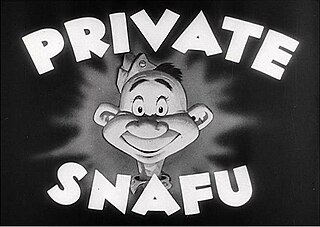
Private Snafu is the title character of a series of black-and-white American instructional adult animated shorts, ironic and humorous in tone, that were produced between 1943 and 1945 during World War II. The films were designed to instruct service personnel about security, proper sanitation habits, booby traps and other military subjects, and to improve troop morale. Primarily, they demonstrate the negative consequences of doing things wrong. The main character's name is a play on the military slang acronym SNAFU, "Situation Normal: All Fucked Up". The cleaned-up version of that phrase, usually used on radio and in print, was "Situation Normal: All Fouled Up".

Tortoise Wins by a Hare is a Merrie Melodies cartoon released on February 20, 1943, and directed by Bob Clampett. It stars Bugs Bunny and Cecil Turtle. It is a sequel to 1941's Tortoise Beats Hare, with footage from said cartoon briefly shown at the beginning. It is also the first short to feature Robert McKimson's design of Bugs Bunny.

Hare Force is a 1944 Warner Bros. cartoon in the Merrie Melodies series, directed by Friz Freleng. The cartoon was released on July 22, 1944, and stars Bugs Bunny.
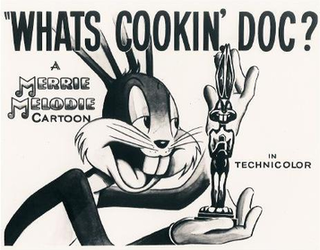
What's Cookin' Doc? is a 1943-produced, 1944 Warner Bros. cartoon in the Merrie Melodies series, directed by Bob Clampett, and stars Bugs Bunny. The short was also written by Michael Sasanoff, and was animated by Robert McKimson, along with uncredited work by Rod Scribner, Phil Monroe and Virgil Ross. The film was released on January 8, 1944.
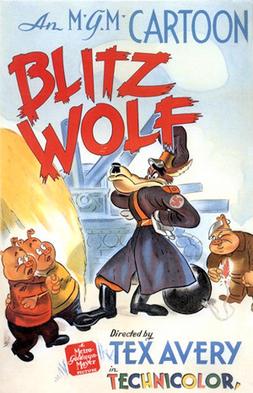
Blitz Wolf is a 1942 American animated propaganda short film produced and distributed by Metro-Goldwyn-Mayer. A parody of the Three Little Pigs told via a World War II perspective, the short was directed by Tex Avery and produced by Fred Quimby. It was nominated for the Academy Award for Best Short Subject: Cartoons but lost to Der Fuehrer's Face, another anti-Nazi World War II parody featuring Donald Duck.

Spies is part of the Private Snafu series of animated shorts produced by Warner Bros. during World War II. Released in 1943, the cartoon was directed by Chuck Jones and features the vocal talents of Mel Blanc. It was included as part of the International Spy Museum exhibits, specifically the exhibit showcasing World War II-era spying.
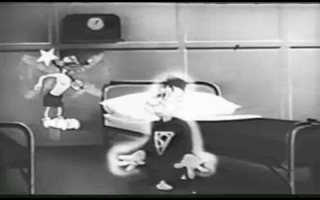
Snafuperman is a 1944 animated short comedy produced by Warner Bros. and directed by Friz Freleng. It is one of a series of black and white "Private Snafu" cartoons created for the Army-Navy Screen Magazine and shown only to American soldiers. The "Private Snafu" cartoons were not released commercially, until December 2010. The cartoon's title is a play on "Superman" and parodies the popular Superman cartoons of the 1940s.
Bacall to Arms is a 1946 Warner Bros. Merrie Melodies series short planned by Bob Clampett and finished by Arthur Davis, in his second-to-last cartoon at Warner Bros. The short was released on August 3, 1946.

Private Snafu vs. Malaria Mike is an animated short film, directed by Chuck Jones and first released in March 1944. It features Private Snafu facing a malaria-transmitting mosquito.
Of Thee I Sting is a 1946 Warner Bros. cartoon directed by Friz Freleng, written by Michael Maltese and narrated by Robert C. Bruce that is a parody of World War II documentaries. Material was reused from the Target Snafu cartoon. The short was released on August 17, 1946.

A Lecture on Camouflage is a 1944 American animated film directed by Chuck Jones, a Private Snafu cartoon short made for the troops during World War II.
World War II changed the possibilities for animation. Prior to the war, animation was mostly seen as a form of family entertainment. The attack on Pearl Harbor was a turning point in its utility. On December 8, 1941, the United States Army began working with Walt Disney at his studio, stationing Military personnel there for the duration of the war. The Army and Disney set about making various types of films for several different audiences. Most films meant for the public included some type of propaganda, while films for the troops included training and education about a given topic.

Commando Duck is a Walt Disney anti-Japanese propaganda cartoon starring Donald Duck. It was released on June 2, 1944.
Gas is an animated short, directed by Chuck Jones and first released in May 1944. It features Private Snafu learning the value of a gas mask in warfare. The cartoon was produced by Warner Bros. Cartoons. The script writers for the Snafu cartoons were typically uncredited, though animation historians consider that several of them were written or co-written by Dr. Seuss and Munro Leaf.
The Chow Hound is an animated short, directed by Frank Tashlin and first released in June 1944. It is part of the Private Snafu series.
Censored is an animated short, directed by Frank Tashlin, produced by Leon Schlesinger and first released in July 1944. It is part of the Private Snafu series.
Outpost is an animated short film, directed by Chuck Jones and first released in August 1944. It is part of the Private Snafu series. As in all the Snafu films, the voice of Private Snafu is performed by Mel Blanc.
Payday is an animated short film, directed by Friz Freleng and first released in September 1944. It is part of the Private Snafu series. As in all the Snafu films, the voice of Private Snafu is performed by Mel Blanc.
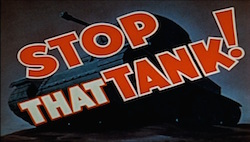
Stop That Tank! is a 22-minute 1942 instructional film created during World War II by Walt Disney Productions for the Directorate of Military Training, The Department of National Defence and the National Film Board of Canada (NFB). Its purpose, akin to "edutainment", was to instruct Canadian soldiers in the handling and care of the Boys Mk.1 Anti-tank rifle for use in combat against Nazi tanks. The film presented information in an entertaining manner as well as providing an anti-Nazi propaganda message.

Scrap the Japs is a 1942 American anti-Japanese cartoon with the popular character Popeye as protagonist. It follows his adventures after being sent for punishment on a ship and running into Japanese sailors.










